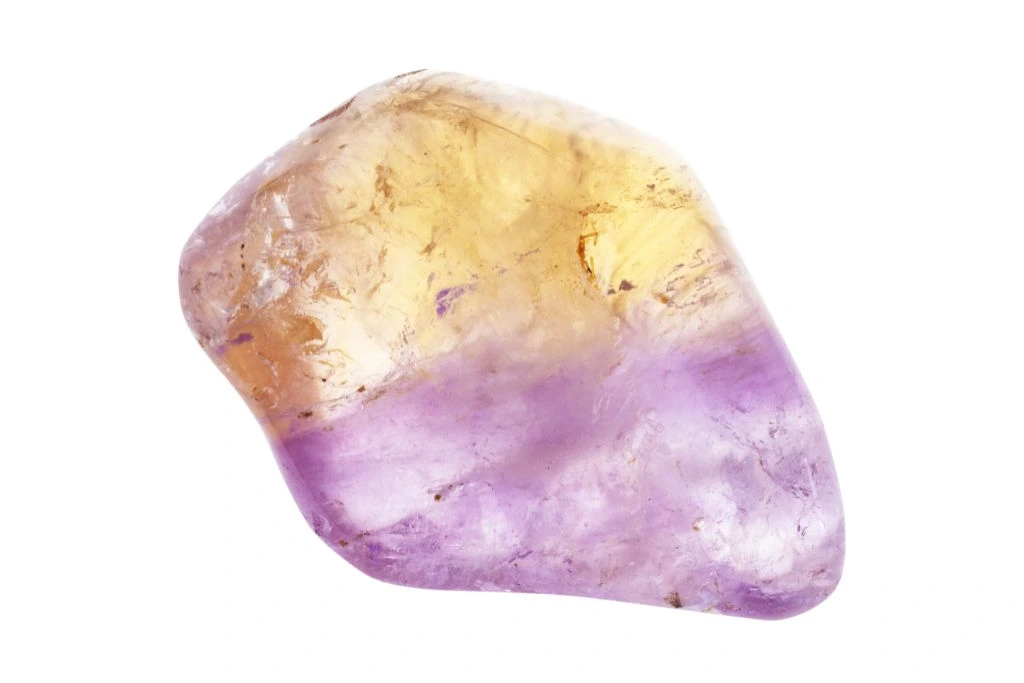Color and Appearance of Ametrine
Ametrine is a captivating gemstone that showcases a striking combination of purple and yellow hues within a single crystal. This unique color zoning is the most distinctive feature of ametrine, creating a visually stunning effect that sets it apart from other gemstones. The purple portions resemble amethyst, while the yellow areas are reminiscent of citrine, hence the name “ametrine” – a portmanteau of these two quartz varieties.
Crystal Structure and Formation
Ametrine belongs to the quartz family and exhibits the typical hexagonal crystal structure of quartz minerals. The crystal forms as a result of differential oxidation states of iron within the same crystal during its growth. This process leads to the development of distinct color zones, with some areas containing oxidized iron (producing the purple hue) and others containing reduced iron (resulting in the yellow coloration).
Physical Characteristics
Like other quartz varieties, ametrine has a hardness of 7 on the Mohs scale, making it relatively durable for use in jewelry. It possesses a vitreous luster and is transparent to translucent. The gemstone typically displays a clear, sharp boundary between its purple and yellow sections, though some specimens may show a more gradual transition between the two colors.
Unique Features
What truly makes ametrine stand out is its pleochroism – the ability to show different colors when viewed from different angles. This property enhances the gem’s visual appeal and can be particularly striking when the stone is cut to emphasize the color zoning. Skilled lapidaries often orient the cut to maximize the contrast between the purple and yellow zones, creating eye-catching patterns and color play that captivate observers and jewelry enthusiasts alike.
Historical and Cultural Significance of Ametrine
Ametrine, a unique gemstone combining amethyst and citrine, has been revered for centuries. This fascinating crystal was first discovered in the Anahi mine in Bolivia, where it held great importance to indigenous peoples. The Ayoreo tribe, native to the region, considered ametrine a gift from the gods and used it in various spiritual practices. Spanish conquistadors later introduced ametrine to Europe, where it quickly gained popularity among royalty and nobility.
Metaphysical Associations
In the realm of crystal healing, ametrine is believed to possess a powerful combination of properties from both amethyst and citrine. It is said to balance and harmonize the yin and yang energies within the body, promoting mental and emotional equilibrium. Many practitioners associate ametrine with the solar plexus and crown chakras, believing it can enhance intuition, creativity, and personal power while reducing stress and anxiety.
Common Uses and Benefits
Ametrine is widely used in jewelry making, with its unique color combination making it a popular choice for statement pieces. In alternative medicine, it is often employed in crystal therapy sessions to address a variety of concerns. Some believe that ametrine can help alleviate headaches, boost the immune system, and improve overall vitality. Meditation enthusiasts often incorporate ametrine into their practice, using it as a focus object to enhance concentration and spiritual awareness.
Modern Applications
In recent years, ametrine has gained popularity in the wellness industry. It is frequently used in aromatherapy diffusers and incorporated into spa treatments. Some modern crystal enthusiasts place ametrine in their work environments, believing it can enhance productivity and decision-making skills. Additionally, the gemstone has found its way into various forms of energy healing, where practitioners use it to balance and cleanse the aura.

